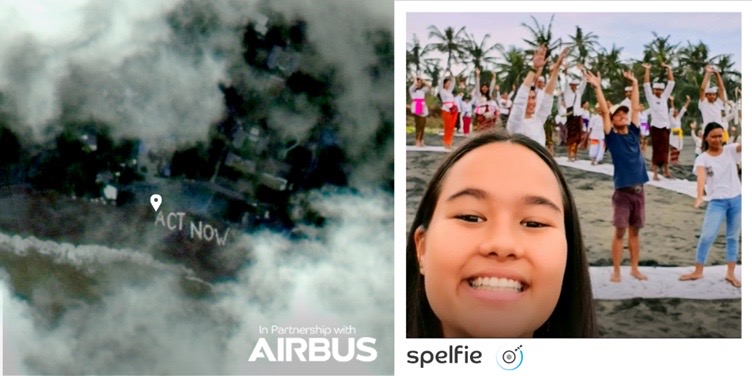
Space selfies are now a thing.
A free app called Spelfie lets users snap photos of themselves from very high above, courtesy of cameras aboard Airbus Earth-observation satellites.
Those cameras aren't powerful enough to capture your grinning face, of course (though they can pick out individual trees and cars, according to Spelfie representatives). But space selfies can provide a new perspective on your attendance at big events like concerts and football games, or serve as platforms for getting the word out about issues that are important to you.
Related: Earth Day 2019: These Amazing NASA Images Show Earth from Above
For example, the first-ever "spelfie," taken this past June, features a group of people lined up on a beach to form the words "Act Now." These folks are villagers on the Indonesian island of Bali, and they're trying to raise awareness about the scourge of plastic pollution afflicting this tropical paradise and many other places around the world.
That pioneering spelfie was just revealed this week in the BBC documentary "Saving Our Beautiful Bali," which chronicles the efforts of teenage environmental campaigner (and "Act Now" organizer) Isabel Wijsen.
"Spelfie is a movement of people who want to change the world and make a difference through social media and imagery," Chris Newlands, CEO of Scotland-based Spelfie, said in a statement. "The power of a spelfie can help raise awareness globally, encouraging others to join in and want to make a difference, too, just as Isabel did for the Bye Bye Plastic Bags movement in Bali."
Get the Space.com Newsletter
Breaking space news, the latest updates on rocket launches, skywatching events and more!
In case you're wondering how a spelfie works, that same statement provides the following explainer: "Once an event has been confirmed on the Spelfie app by partners and sponsors, the user then chooses the event they wish to attend. They then take a selfie at the designated time and place and wait for their spelfie to land from space on the same day."
The cameras aboard the Airbus satellites are optical, meaning they cannot peer through clouds. So the weather has to cooperate for your spelfie to come through as planned.
- Mars Rover Curiosity Snaps Beautiful Selfie After Rare Chemistry Experiment
- Photos: Amazing Images of Earth from Space
- Earth from Space in 2017: DigitalGlobe's Most Impactful Photos
Mike Wall's book about the search for alien life, "Out There" (Grand Central Publishing, 2018; illustrated by Karl Tate), is out now. Follow him on Twitter @michaeldwall. Follow us on Twitter @Spacedotcom or Facebook.

Join our Space Forums to keep talking space on the latest missions, night sky and more! And if you have a news tip, correction or comment, let us know at: community@space.com.

Michael Wall is a Senior Space Writer with Space.com and joined the team in 2010. He primarily covers exoplanets, spaceflight and military space, but has been known to dabble in the space art beat. His book about the search for alien life, "Out There," was published on Nov. 13, 2018. Before becoming a science writer, Michael worked as a herpetologist and wildlife biologist. He has a Ph.D. in evolutionary biology from the University of Sydney, Australia, a bachelor's degree from the University of Arizona, and a graduate certificate in science writing from the University of California, Santa Cruz. To find out what his latest project is, you can follow Michael on Twitter.









